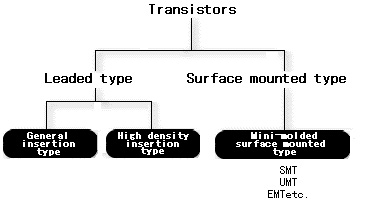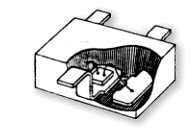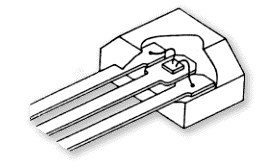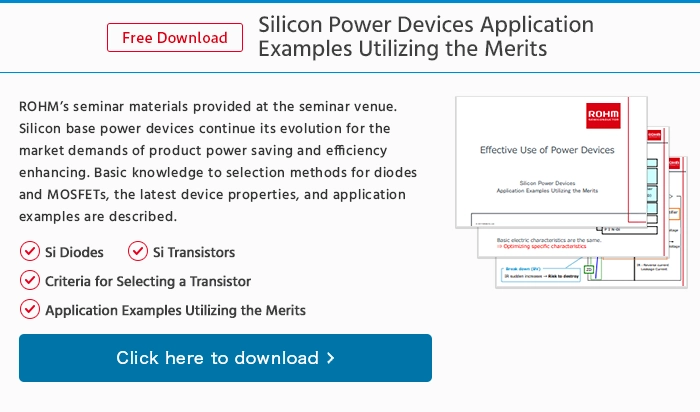Outline of a Transistor <Classification>
Classified according to the shape.

The size and shape of the transistor are determined by the power consumption and method of mounting. Broadly, transistors can be classified into leaded type and surface mounted type.
Typical Shapes of Transistors
(The figures show the cross-sectional views)


Classification According to Construction
Transistors typically fall into two main types depending on their construction. These two types are bipolar junction transistors (BJT) and Field Effect Transistors (FET).

Bipolar Transistors
The word "bipolar" consists of two root words. Bi (meaning "two"), and polar (meaning "opposites"). A bipolar transistor is one in which the current through the transistor is carried by holes (positive polarity) and electrons (negative polarity). Bipolar junction transistors were the first type of transistor to be mass-produced in 1947 in the form of the point contact transistor (Bell Labs). They are a combination of two junction diodes, and are formed from either a thin layer of p-type semiconductor sandwiched between two n-type semiconductors (an n–p–n transistor), or a thin layer of n-type semiconductor sandwiched between two p-type semiconductors (a p–n–p transistor).FETs
FETs (Field Effect Transistors) can generally be classified into three different types; junction type FETs, MOS (Metal-Oxide-Semiconductor) type FETs, and MES (Metal-Semiconductor) type FETs. Junction type FETs are mostly used in analog circuits such as those in audio equipment, and MOS type FETs are used mostly in digital ICs such as those used in microcomputers. MES type FETs are used for amplification of microwaves such as use in satellite broadcasting transceivers.Classification According to Permissible Power
There are two broad classifications of transistors according to their permissible power: small-signal transistors and power transistors. These classifications are based primarily on the maximum rating of the collector power dissipation Pc.

Small-Signal Transistors
These are transistors whose maximum collector current (IC(max)) is about 500mA or less and the maximum collector power dissipation (Pc(max)) is less than 1W. These transistors are called small-signal transistors to distinguish them from power transistors and have the feature that they are generally of the epoxy molded type.
Power Transistors
If a transistor has a Pc of 1W or more, it is commonly classified as a power transistor. Compared to small-signal transistors, power transistors have a larger maximum collector current, maximum collector power dissipation, and also have a larger size to meet the heat dissipation. They are generally shielded by metal or have a structure with heat radiating fins.
In Japan, a transistor is called a "stone". The word transistor is a combination of Transfer and resistor. Since a transistor is made of silicon which is the major element in all the rocks and stones on earth, many Japanese designers refer to a transistor as a stone.
Classification According to the Type of Integration
Apart from discrete type transistors, ROHM is also manufacturing composite transistors. These integrate several transistors together in order to meet various users needs. These include digital transistors with built-in resistors, transistor arrays consisting of multiple transistors in one package, and transistor units with simple circuits built into them.

Discrete Transistors
These are individually packaged transistors. They are becoming less common as the vast majority of transistors are now produced in integrated circuits along with diodes, resistors, capacitors and other electronic components, to produce complete electronic circuits.
Composite Transistors
A composite transistor (sometimes known as Darlington transistor) is a combination of two or more transistors (typically bipolar junction transistors) with the purpose of increasing the current gain.
*Digital Transistors
A digital transistor is a bipolar transistor with built-in resistors. These are the standard transistors that are used in circuit design.





